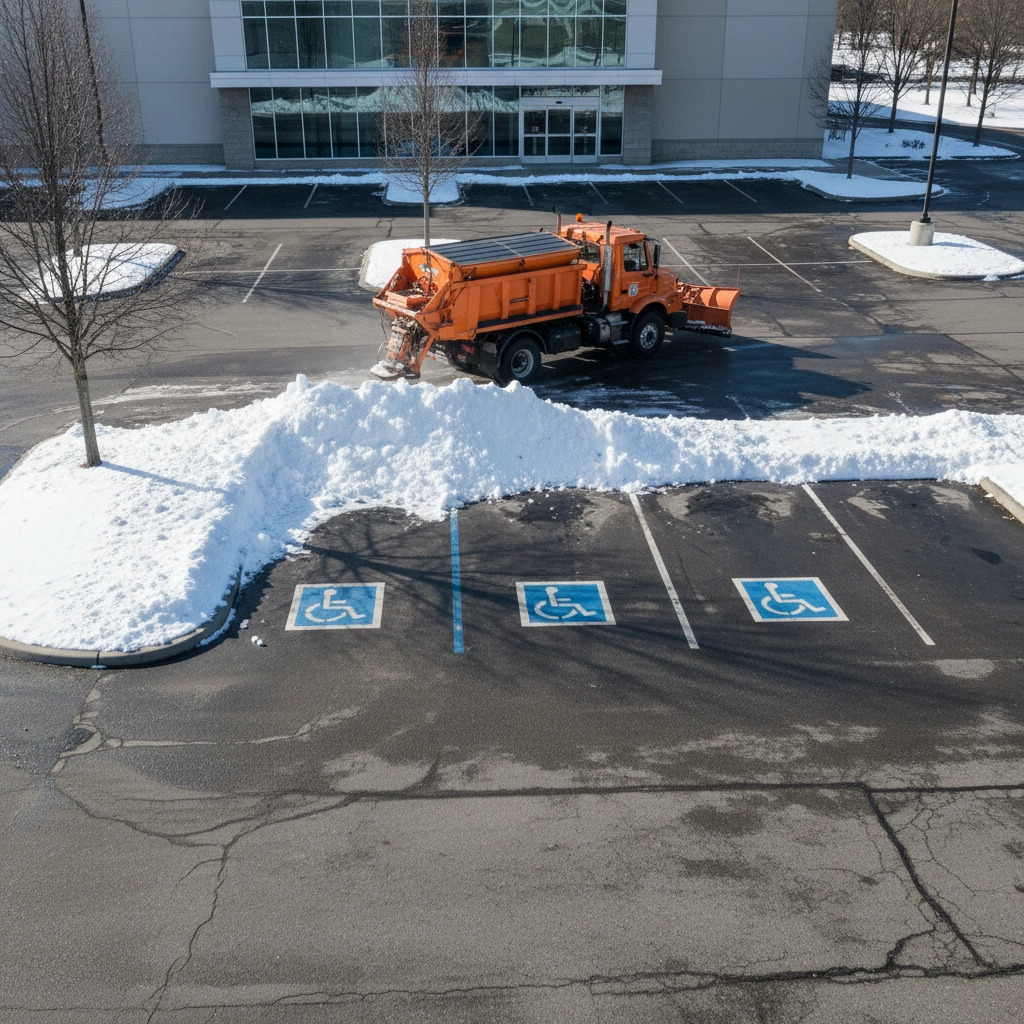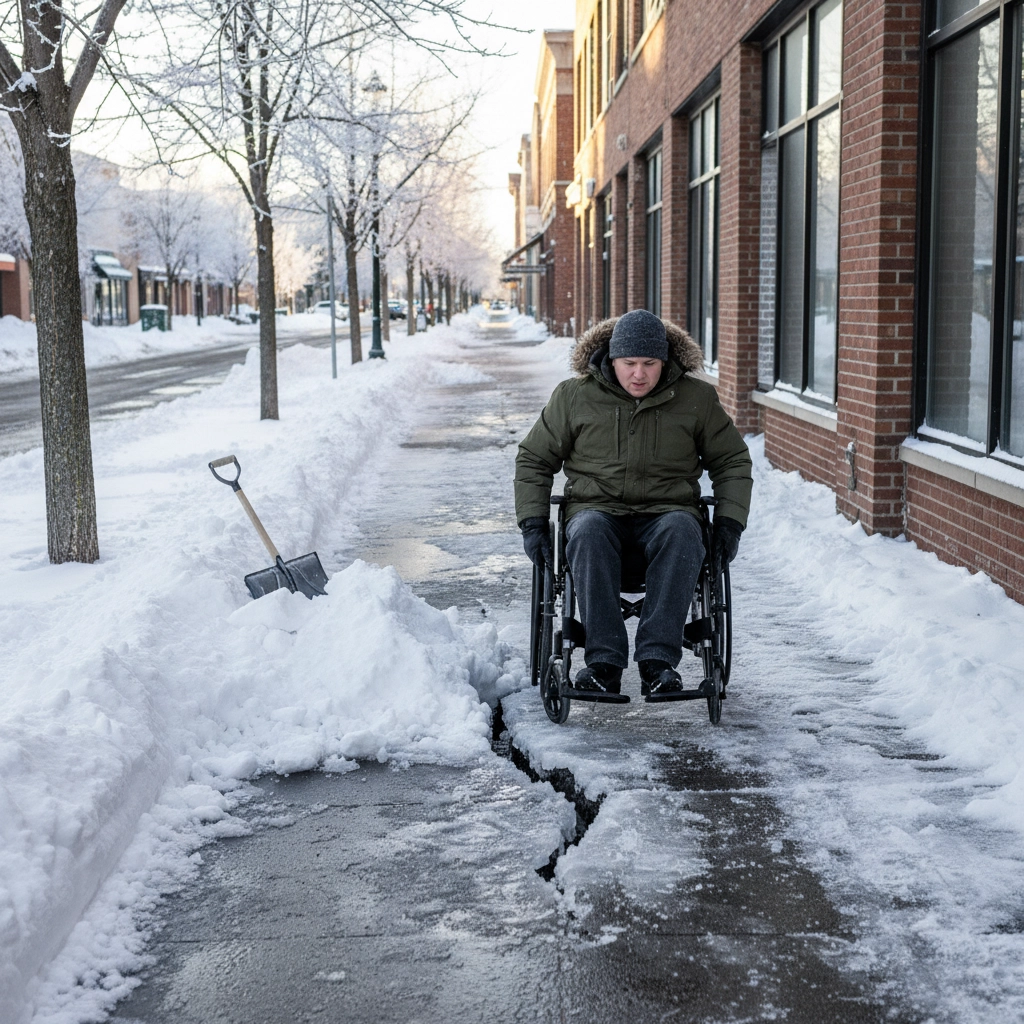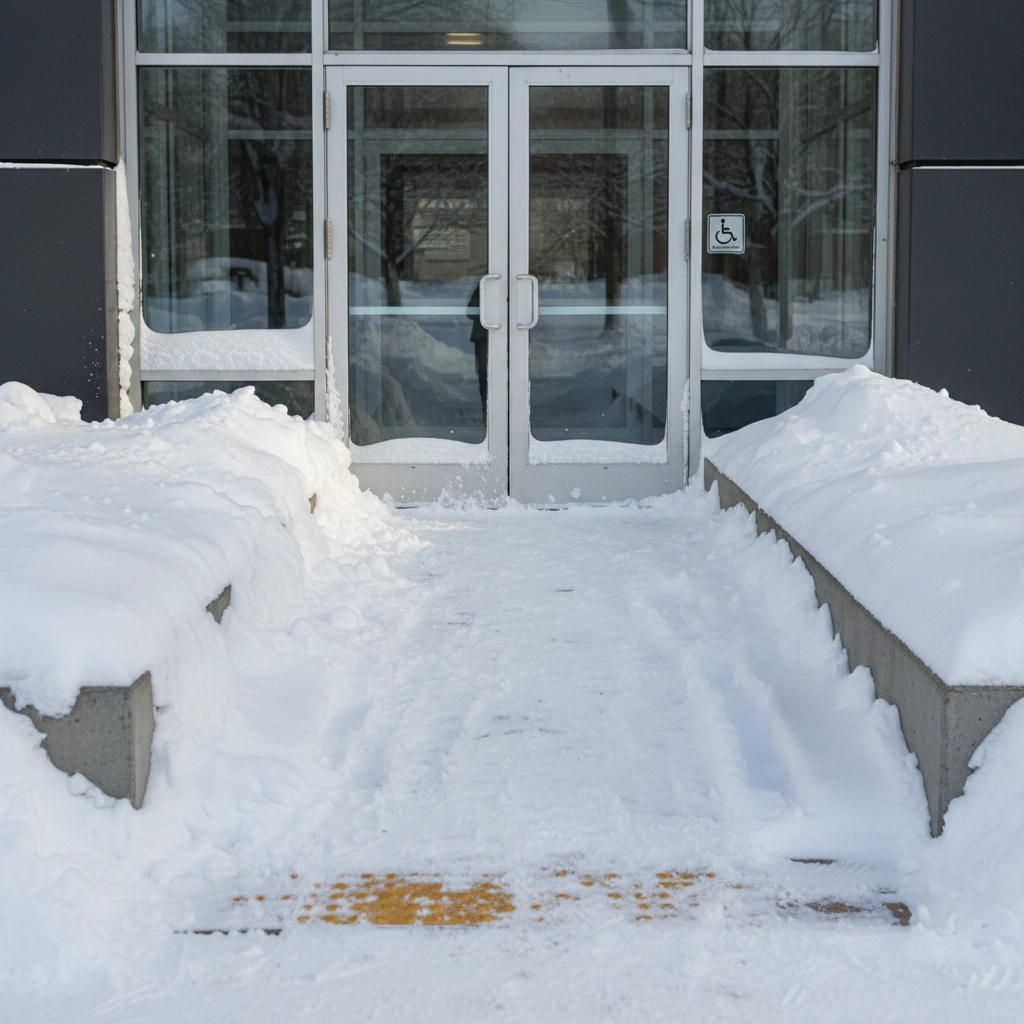Are You Making These 5 Costly ADA Compliance Mistakes During Snow Removal?

Winter in Northeast Ohio brings more than just snow: it brings serious legal responsibilities. Property managers who think snow removal is just about clearing walkways are setting themselves up for expensive ADA compliance violations that can cost thousands in fines and lawsuits.
The Americans with Disabilities Act doesn't take a snow day, and neither should your compliance efforts. Every storm season, businesses across Ohio face penalties because they've overlooked critical accessibility requirements during snow removal operations.
Mistake #1: Plowing Snow Into Accessible Parking Spaces
Here's the scene: Your snow removal crew arrives at 4 AM, plows are running, and they're pushing snow to the most convenient spots: which often happen to be those wide-open accessible parking spaces and access aisles.
This is one of the costliest mistakes you can make. When you block accessible parking spaces with snow, you're essentially telling customers with disabilities they can't visit your business. The access aisle next to handicap spots isn't just extra space: it's legally required clearance for wheelchair lifts and mobility equipment.
The Real Cost: In Ohio, ADA violations for inaccessible parking can result in federal fines up to $75,000 for first offenses. New York imposes $25-$100 fines per incident, while New Jersey hits violators with $200-$500 penalties under their Snow Removal Act. But the bigger risk? Discrimination lawsuits that can cost tens of thousands in legal fees and settlements.
The Fix: Train your snow removal team to treat accessible spaces as completely off-limits for snow placement. Mark these areas clearly on property maps and establish designated snow storage areas away from accessible routes.

Mistake #2: Clearing Only the "Main" Walkways
Many property managers focus on high-traffic areas like main entrances while ignoring the complete accessible route. But here's what the ADA actually requires: if you provide an accessible route, the entire path must remain accessible and unobstructed.
This means clearing everything from the accessible parking space, through the access aisle, across curb cuts, along sidewalks, and right up to building entrances. Missing even one section breaks the chain of accessibility.
The Real Cost: Incomplete route clearing creates liability for slip-and-fall injuries and can trigger ADA compliance investigations. In Northeast Ohio's freeze-thaw cycles, partially cleared routes become ice hazards that increase your insurance risk exponentially.
The Fix: Map out your complete accessible routes before snow season. Create a checklist for your crew that covers every segment from parking to entrance. Consider these routes as priority #1: clear them first, clear them completely.
Mistake #3: Forgetting About Curb Ramps and Entrances
Curb ramps are the critical transition points that wheelchair users depend on, yet they're frequently buried under snow piles or ignored during removal. The same goes for building entrances: that small mound of snow in front of your door might seem insignificant, but it's an insurmountable barrier for someone using mobility equipment.
Door thresholds must be completely clear, and curb ramps need to be fully functional, not just "mostly" cleared. A partially cleared ramp with ice buildup is actually more dangerous than an obviously blocked one.
The Real Cost: Blocked entrances can shut down your business for customers with disabilities, creating grounds for discrimination complaints. In commercial settings, this can mean lost revenue and potential legal action from customers who couldn't access your services.
The Fix: Assign specific crew members to focus solely on curb ramps and entrances. Use ice melt products designed for these high-priority areas, and check them multiple times during ongoing storms.

Mistake #4: The "We'll Get to It Eventually" Approach
The ADA requires snow removal to happen "as quickly as reasonably possible": not when it's convenient or when you get around to it. Many properties make the mistake of treating accessible features as a lower priority than general snow clearing.
In Northeast Ohio, where lake-effect snow can dump several inches in just hours, delays in clearing accessible routes can quickly compound into major problems. What starts as a 2-inch snowfall becomes a frozen, impassable barrier by the next morning.
The Real Cost: Extended delays can result in federal ADA investigations and compliance orders. Some states have specific timeframes: New Jersey requires accessible parking to be cleared within 48 hours of weather clearing. Miss these deadlines, and you're looking at automatic violations.
The Fix: Develop a tiered response system where accessible features get cleared first, regardless of overall property priorities. Consider investing in equipment specifically sized for accessible routes, like smaller plows or specialized ice removal tools.
Mistake #5: Operating Without an ADA Snow Removal Plan
This is the big one: the mistake that makes all the others inevitable. Too many property managers approach snow removal reactively, without a comprehensive plan that addresses ADA requirements from the start.
Without proper planning, you're essentially gambling with compliance every time it snows. Your crews don't know the priorities, your equipment isn't appropriate for accessible features, and you don't have backup plans for extended storms.
The Real Cost: Operating without a plan means facing preventable violations repeatedly throughout the season. Emergency snow removal services cost 3-5 times more than planned operations, and establishing temporary alternate access routes requires expensive professional consultation and approval.
The Fix: Develop a written ADA snow removal policy before November. Include detailed property maps marking all accessible routes, training protocols for staff and contractors, equipment specifications, and emergency procedures for extended storms.

Northeast Ohio-Specific Considerations
Our region's unique weather patterns create additional challenges. Lake-effect snow can dump heavy amounts quickly, while frequent freeze-thaw cycles create ice hazards that persist long after snowfall ends.
Consider investing in heated snow removal systems for critical accessible routes, or at minimum, ensure you have adequate ice melt supplies specifically for ADA-priority areas. The ice storms we see in January and February can make even well-cleared accessible routes impassable without proper treatment.
Taking Action Before the Next Storm
Don't wait for the next compliance violation to take ADA snow removal seriously. Start by conducting a pre-season audit of all your accessible routes. Walk the path from every accessible parking space to every building entrance, and document exactly what needs to be maintained.
Train your entire snow removal team: whether in-house staff or contractors: on ADA requirements specific to your property. Make sure they understand that accessible routes aren't just "nice to have" clear: they're legally required to be maintained.
Ready to ensure your commercial property stays ADA-compliant all winter long? LeafStone Landscapes specializes in commercial snow and ice management with full ADA compliance protocols. Contact our team today to discuss a customized snow removal plan that protects your property and your customers' rights throughout Northeast Ohio's challenging winter season.



